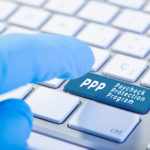By Mark Wright, OD, FCOVD,
and Carole Burns, OD, FCOVD
 May 20, 2020
May 20, 2020
Paycheck Protection Program loans come with rules that, if precisely followed, enable forgiveness of the loans. Here is how to ensure you are meeting the requirements of those rules.
There is a lot of information and misinformation on the internet about PPP forgiveness. The information you can trust comes directly from the Small Business Administration and is published in the Federal Register. If you Google PPP Interim Final Rules, it will take you to the Federal Register documents you need to read.
The SBA just published the Loan Forgiveness Application. This document includes the application itself, a discussion of how to fill out the application and worksheets necessary to create the numbers to go into the application.
It is important to understand how the PPP forgiveness process works. For PPP forgiveness you will need to follow the SBA rules and regulations published in the Federal Register, correctly fill out the SBA Loan Forgiveness Application and follow the rules created by the bank that gave you your PPP loan. Bank rules may vary from bank to bank, so you will need to contact the bank that loaned you the PPP money and ask if they have any rules that are different from the SBA rules or have an interpretation of SBA rules that you need to know.
What are the SBA rules we need to know in order to gain forgiveness?
The first rule is that a minimum of 75 percent of your PPP loan must go to payroll.
To meet the requirements of this rule you must pay your employees at current salary levels without any reductions in wages or headcount. In addition to wages, payroll also includes health-care benefits and retirement plan funding, The specific wording used in the Loan Forgiveness Application is:
Other Pieces to Explore
“Borrowers are generally eligible for forgiveness for the payroll costs paid and payroll costs incurred during the eight-week (56-day) Covered Period (or Alternative Payroll Covered Period) (“payroll costs”). Payroll costs are considered paid on the day that paychecks are distributed or the Borrower originates an ACH credit transaction. Payroll costs are considered incurred on the day that the employee’s pay is earned. Payroll costs incurred but not paid during the Borrower’s last pay period of the Covered Period (or Alternative Payroll Covered Period) are eligible for forgiveness if paid on or before the next regular payroll date. Otherwise, payroll costs must be paid during the Covered Period (or Alternative Payroll Covered Period). For each individual employee, the total amount of cash compensation eligible for forgiveness may not exceed an annual salary of $100,000, as prorated for the covered period. Count payroll costs that were both paid and incurred only once. For information on what qualifies as payroll costs, see Interim Final Rule on Paycheck Protection Program posted on April 2, 2020 (85 FR 20811).”
The Alternative Payroll Covered Period is defined in the Loan Forgiveness Application as:
“For administrative convenience, Borrowers with a biweekly (or more frequent) payroll schedule may elect to calculate eligible payroll costs using the eight-week (56-day) period that begins on the first day of their first pay period following their PPP Loan Disbursement Date (the “Alternative Payroll Covered Period”). For example, if the Borrower received its PPP loan proceeds on Monday, April 20, and the first day of its first pay period following its PPP loan disbursement is Sunday, April 26, the first day of the Alternative Payroll Covered Period is April 26 and the last day of the Alternative Payroll Covered Period is Saturday, June 20. Borrowers who elect to use the Alternative Payroll Covered Period must apply the Alternative Payroll Covered Period wherever there is a reference in this application to “the Covered Period or the Alternative Payroll Covered Period.” However, Borrowers must apply the Covered Period (not the Alternative Payroll Covered Period) wherever there is a reference in this application to ‘the Covered Period’ only.”
The second rule is that a maximum of 25 percent of your PPP loan can go to other “covered” expenses.
These other “covered” expenses are identified in the Loan Forgiveness Application as:
“(a) covered mortgage obligations: payments of interest (not including any prepayment or payment of principal) on any business mortgage obligation on real or personal property incurred before February 15, 2020 (“business mortgage interest payments”);
(b) covered rent obligations: business rent or lease payments pursuant to lease agreements for real or personal property in force before February 15, 2020 (“business rent or lease payments”); and
(c) covered utility payments: business payments for a service for the distribution of electricity, gas, water, transportation, telephone, or internet access for which service began before February 15, 2020 (“business utility payments”).”
The third rule is that you cannot misuse the PPP loan funds.
What happens if the PPP loan funds are used for unauthorized purposes? The federal government has been very clear in its answer to this question:
“If you use PPP funds for unauthorized purposes, SBA will direct you to repay those amounts. If you knowingly use the funds for unauthorized purposes, you will be subject to additional liability such as charges for fraud.”
Follow the rules and do not try to be creative in an attempt to create a windfall for yourself. Banks and the SBA are looking over your documentation and will catch you if you’re trying to play games.
As people begin to fill out the Loan Forgiveness Application this will cause banks and people who received the PPP loans to ask for clarification and more direction. We will continue to update you as more information becomes available.
References
i. https://content.sba.gov/sites/default/files/2020-05/3245-0407 SBA Form 3508 PPP Forgiveness Application.pdf
ii. Rules and Regulations Federal Register 20811 Vol. 85, No. 73 Wednesday, April 15, 2020




























